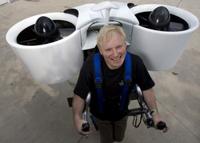-
Self-guided bullet can hit target a mile away
Researchers have designed a self-guided bullet; the dart-like, self-guided bullet for small-caliber, smooth-bore firearms that hit laser-designated targets at distances of more than a mile
-
-
Smiths Detection unveils new portable chemical detector
Earlier this month Smiths Detection unveiled its latest chemical detector, a portable device that combines high speed, high-resolution gas chromatography and a miniaturized toroidal ion trap mass spectrometer
-
-
55 dog teams to sniff out explosives at Olympics
At the upcoming London Olympic Games, more than 150 bomb-sniffing dogs will be on hand to detect any potential threats
-
-
NYPD developing concealed gun detecting tech
The New York Police Department (NYPD) is currently at work on a device that can detect if a person is carrying a concealed firearm from as far as eighty-two feet away
-
-
Indianapolis emergency response center opens days before Super Bowl
With only a few days left until Super Bowl XLVI, which will be held in Indianapolis this year, security officials there unveiled a new emergency coordination center on Wednesday
-
-
N.J. city augments surveillance cameras with spotlights
Over the next three months, the East Orange police department will connect high-powered spotlights to their surveillance camera system, so that when camera operators spot suspicious activity they can turn on the bright lights of justice and deter would be criminals
-
-
First responders could be zipping through skies within two years

Glenn Martin, the inventor of the Martin Jetpack, the world’s first commercially available jetpack, recently spoke with Homeland Security NewsWire’s executive editor Eugene K. Chow; in their interview Martin discusses the technical challenges of developing a viable jetpack, its uses in emergency response, and when we can expect to see civilians zipping through the skies
-
-
Smart911 technology improves 9-1-1- response
Municipalities improve 9-1-1 response with Smart911; the technology allows individuals to use a Web site to enter emergency-relevant information they want emergency personnel answering a 9-1-1 call to have, including children’s photos, medical conditions, disabilities, home addresses of cellphone callers, or other rescue-related information
-
-
GPS trackers help catch copper thieves
With thieves continuing to steal copper wiring and wreaking havoc on critical infrastructure systems across the United States, some security officials have taken to installing GPS tracking devices in copper wire to put an end to the growing problem
-
-
Supreme Court rules against GPS tracking
On Monday, in a landmark case, the Supreme Court ruled that law enforcement agencies needed a judge’s approval before using GPS technology to track a suspect
-
-
High-tech developments help end high-speed pursuits safely
New technological developments are helping police officers end high-speed pursuits without jeopardizing the safety of themselves or the suspect
-
-
Reduced prices for license plates readers attracts more buyers
Now that the cost of Automatic License Plate Readers (ALPR) has dropped $17,000 from its initial price of $24,000, these devices are becoming increasingly common with more and more police departments across the country purchasing them
-
-
Also noted
Minn. police give body cams a tryout | Law enforcement technology aims to step up policing |New Jersey paves the way for stun gun deployment | Tomorrow’s law enforcement technology today | 18th century wisdom guides Supreme Court’s GPS ruling | Technology helps police become more efficient | Smart911 sees rapid growth in 2011
-
-
Spike in violent incidents in hospitals

Over the past decade, hospitals across the nation have been subject to an alarming increase in violent incidents; in the last five years alone, there has been nearly a 300 percent increase in the number of reported homicides, assaults, and rapes compared to the previous five years
-
-
Police chiefs at White House to discuss domestic radicalization
Law enforcement officials from state and local agencies across the United States gathered on Wednesday at the White House to discuss the delicate balance between safeguarding against domestic extremism and maintaining the trust of the residents they serve
-
More headlines
The long view
Are We Ready for a ‘DeepSeek for Bioweapons’?
Anthropic’s Claude 4 is a warning sign: AI that can help build bioweapons is coming, and could be widely available soon. Steven Adler writes that we need to be prepared for the consequences: “like a freely downloadable ‘DeepSeek for bioweapons,’ available across the internet, loadable to the computer of any amateur scientist who wishes to cause mass harm. With Anthropic’s Claude Opus 4 having finally triggered this level of safety risk, the clock is now ticking.”
“The Federal Government Is Gone”: Under Trump, the Fight Against Extremist Violence Is Left Up to the States
As President Donald Trump guts the main federal office dedicated to preventing terrorism, states say they’re left to take the lead in spotlighting threats. Some state efforts are robust, others are fledgling, and yet other states are still formalizing strategies for addressing extremism. With the federal government largely retreating from focusing on extremist dangers, prevention advocates say the threat of violent extremism is likely to increase.
Luigi Mangione and the Making of a ‘Terrorist’
Discretion is crucial to the American tradition of criminal law, Jacob Ware and Ania Zolyniak write, noting that “lawmakers enact broader statutes to empower prosecutors to pursue justice while entrusting that they will stay within the confines of their authority and screen out the inevitable “absurd” cases that may arise.” Discretion is also vital to maintaining the legitimacy of the legal system. In the prosecution’s case against Luigi Mangione, they charge, “That discretion was abused.”
Autonomous Weapon Systems: No Human-in-the-Loop Required, and Other Myths Dispelled
“The United States has a strong policy on autonomy in weapon systems that simultaneously enables their development and deployment and ensures they could be used in an effective manner, meaning the systems work as intended, with the same minimal risk of accidents or errors that all weapon systems have,” Michael Horowitz writes.
Ukraine Drone Strikes on Russian Airbase Reveal Any Country Is Vulnerable to the Same Kind of Attack
Air defense systems are built on the assumption that threats come from above and from beyond national borders. But Ukraine’s coordinated drone strike on 1 June on five airbases deep inside Russian territory exposed what happens when states are attacked from below and from within. In low-level airspace, visibility drops, responsibility fragments, and detection tools lose their edge. Drones arrive unannounced, response times lag, coordination breaks.
Shots to the Dome—Why We Can’t Model US Missile Defense on Israel’s “Iron Dome”
Starting an arms race where the costs are stacked against you at a time when debt-to-GDP is approaching an all-time high seems reckless. All in all, the idea behind Golden Dome is still quite undercooked.
